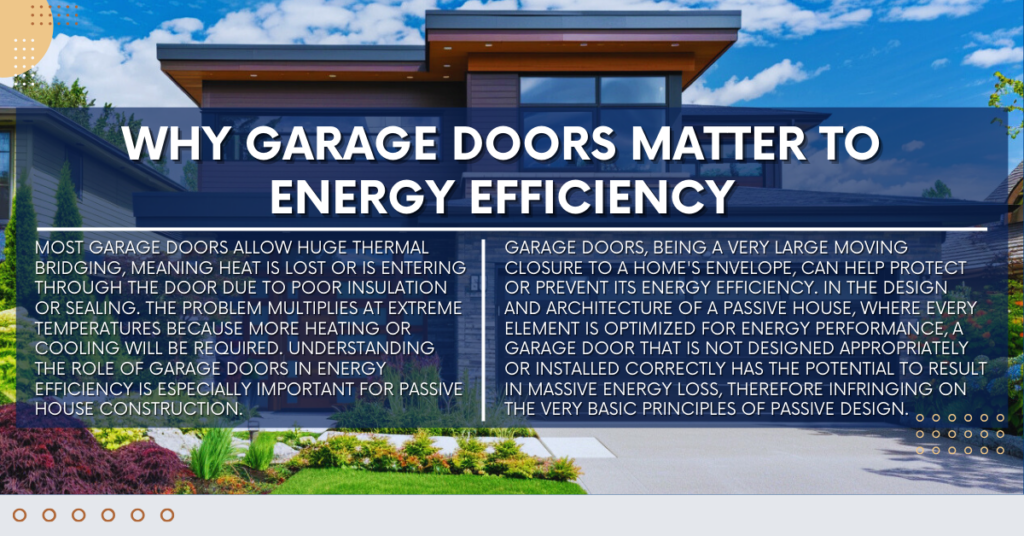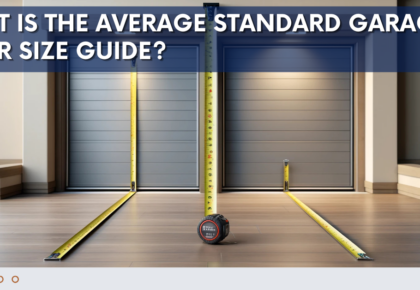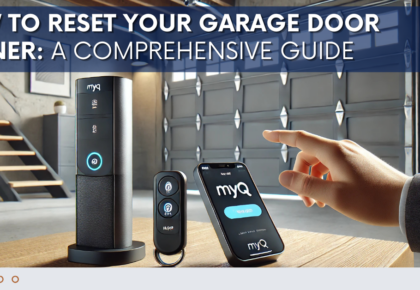In passive house design, every part of the house helps with energy efficiency and sustainability. These homes need very little energy for heating or cooling. This is possible thanks to tight construction, good insulation, and smart designs.
Windows and doors are given special attention. Garage doors take up a lot of space on the outside of a building. They also allow entry to the home. Because of this, they can impact how energy efficient a home is. Despite this, they are often overlooked.
This article highlights the importance of garage doors in passive homes. It also gives tips for choosing and installing them.
These tips can help improve energy savings and support eco-friendly building goals.
The Importance of Garage Doors in Passive House Design
Why Garage Doors Matter to Energy Efficiency

Garage doors, being a very large moving closure to a home’s envelope, can help protect or prevent its energy efficiency. In passive house design, every part is made to save energy. A poorly designed or installed garage door can cause major energy loss. This goes against the core idea of passive design.
Most garage doors allow huge thermal bridging, meaning heat is lost or is entering through the door due to poor insulation or sealing.
The problem multiplies at extreme temperatures because more heating or cooling will be required. Understanding how garage doors affect energy use is important. This is especially true for building passive houses.
Insulation and thermal bridging issues with garage doors
This causes energy loss by settling up a bypass around the insulation, much more at massive areas that see a lot of activity such as garage doors. Choosing a garage door with low thermal bridging and good insulation is important.
Insulated doors use materials like polyurethane foam or polystyrene. These materials keep the warm air inside during winter and block heat during summer.
Insulation is rated, but, according to its effectiveness by the R-value—the higher the R-value, the better the insulation. New garage door designs now include thermal breaks. These are small gaps that stop heat from moving between door panels. This helps keep heat from escaping.
Airtightness: Key to Passive House Standard in Garage Doors.
Airtightness is key to passive house design. It helps reduce energy loss. Large garage doors can weaken this seal. Drafts can enter through gaps and seams. Since tight air sealing is identified, select garage doors that are designed to be airtight.
High-quality seals/gaskets are provided throughout the perimeter of the door. The door comes with well-designed parts like hinges and rollers, making it fit the frame perfectly. Vertical lift and sectional doors usually seal better than swing-out doors because they slide.
An automatic closing system also keeps the door tightly sealed, helping to save energy.
Choosing Eco-Friendly Garage Doors for Passive Homes
Materials Matter: Sustainable Choices for Garage Doors
New garage doors have special thermal breaks. These are gaps that stop heat from moving between door panels. This helps reduce heat loss. Commonly used materials for the construction of a garage door include wood, steel, and composites.
For example, the former is renewable but must come from sustainably managed forests. Recycled steel has two benefits. It gains strength from plastic, and it doesn’t need new raw materials. The alternatives are balanced composites, which mix recycled wood fibers with plastic.
Consider manufacturers who use eco-friendly methods. They might use low-VOC finishes and energy-efficient processes. These steps help reduce environmental impact.
Energy Efficient Garage Door Technologies
With new technology, energy-efficient garage doors now help improve passive house performance. Smart systems let homeowners control and check their garage doors from anywhere. This ensures doors stay closed when not in use, preventing energy loss.
Sensors also add safety by detecting obstacles and reversing the door if needed. Garage doors with windows can use double or triple-glazed glass. Low-emissivity (low-E) glass helps block heat. It also keeps the home insulated.
Choosing the right size and placement for these windows is important. It reduces their effect on the door’s insulation, keeping energy efficiency high.
The Importance of U-Value in Selecting a Garage Door
The U-value of the garage door refers to a crucial value for the thermal performance of the same. It provides the rate at which heat flows through such a door, where a lower U-value means better insulation. In passive house design, the U-value will be more and more used as a result of using appropriate garage doors to avoid losing energy inside a house.
More than an R-value, what needs to happen for measuring up garage doors? The R-value shows how well a material resists heat flow. The U-value considers more factors, like location, direction, and the type of frame, to give a full picture.
To meet or exceed passive house standards, focus on the U-value of the garage door. Reinforce the door for the best results. We can ensure the door contributes more to the entirety of energy efficiency in your home.
Passive House Design Integrated with Garage Doors
Design Considerations for Seamless Integration
Integrating a garage door into a passive home requires thoughtful planning. The door should complement the home’s design while meeting passive house energy standards.
Deciding whether to attach or detach the garage is crucial. A detached garage can cut its impact on the home’s thermal envelope. If your garage is attached to your home, it’s important to insulate and seal the space between them. This helps prevent energy loss.
Also, think about the size and position of your garage door. Smaller doors, or dividing large ones, can help reduce heat loss. Placing doors on sides with less sun, like the north-facing wall, can also improve energy efficiency.
Balance between Aesthetics and Functionality
Energy efficiency is the main focus when designing a passive house. But looks are important too. Generally, a garage door is visible from the front elevation and forms an exterior element of the house. Thus, it has to be designed by the design of the house.
Fortunately, the range of modern garage door types runs from sleek and contemporary to rustic traditional. These doors allow owners to choose a style that matches their home’s design. They also meet energy efficiency standards.
When choosing a garage door, consider the color. Think about the texture, which affects how it looks. Finally, pick the right finish to complete the design. Dark colors absorb more heat and are good in colder climates, but bad in warmer climates.
Lighter colors reflect more sunlight because they bounce it off easily. This helps reduce heat during warm seasons. A textured finish adds interest without hurting performance, like wood grain or brushed metal.
The other thing to be taken into consideration in your choice of door is functionality. The garage door has useful features like auto-open, keyless entry, and light integration. These make it both convenient and safe. It adds both function and style to your home.
Attached Passive Design Strategies for Attached Garages
Attached garages are common in many home designs. But, they create specific challenges for passive house construction. The key to their impact on the home’s thermal envelope lies in creating a thermal buffer zone between the garage and the living space itself.
This may be some non-heated area, like a mudroom or laundry room, which reduces heat transfer and thus improves energy efficiency.
Further, conventional garage ventilation will be responsible for huge energy losses. An HRV, will guarantee good ventilation while recovering 90% of the heat energy to save the home’s effectiveness.
Discussion of General Issues: Ventilation and Safety in a Garage
Ventilation in a garage is important. In projects like passive houses, it’s crucial to stop fumes from entering the living space. This is especially true for carbon monoxide. Traditional methods of garage ventilation can allow a passive house to lose some of its tight air seal and energy efficiency.
Instead, an HRV system should be used. It allows constant ventilation. It saves energy by reusing the heat from the outgoing air. Also, for added safety, you should have carbon monoxide detectors installed both in the garage and in living spaces that are next to a garage.
You also need to prevent an accident, adding the sensors on your garage door so that it will stop when there is something along its path.
Case Studies of Successful Garage Door Integration into Passive Houses
Energy-Efficient Garage Door Real-World Examples
Passive homes with garage doors show how to solve design problems while meeting passive house standards. Case studies offer ideas on balancing function, looks, and energy savings.
For example, one passive home in a cold climate used a very insulated, airtight sectional garage door. The door had a low U-value and thermal breaks to stop heat loss. An HRV system kept the air fresh inside without affecting the home’s airtightness.
In a warm climate, a passive home used a separate garage to lower heat. A small, insulated door on the north side helped reduce heat gain. A smart garage door system was added to close the door automatically, keeping the home cool.
Lessons Learned from Passive House Projects
Each passive house project teaches important lessons about energy efficiency and design. Case studies show that choosing the right materials and keeping the house airtight are crucial. Planning carefully is needed when adding garage doors.
One key point is the need to work closely with builders and manufacturers. This ensures the garage door meets passive house standards, like good insulation and airtight seals.
Thinking about garage doors early in the design process can help avoid expensive fixes later. It also makes sure the door adds to the home’s energy efficiency.
Conclusion
Garage doors play an important role in keeping passive homes efficient. Homeowners can keep the quality of passive house design by making smart choices. Pick the right materials, technology, and design for garage doors.
As more people want sustainable, energy-saving homes, garage doors will play a bigger role. Architects, builders, and carpenters will need to focus on how they fit into these designs.
Although often overlooked, garage doors can greatly affect a home’s energy performance. Choosing a garage door that meets passive house standards helps save energy. It also reduces environmental harm and supports a more sustainable lifestyle.








